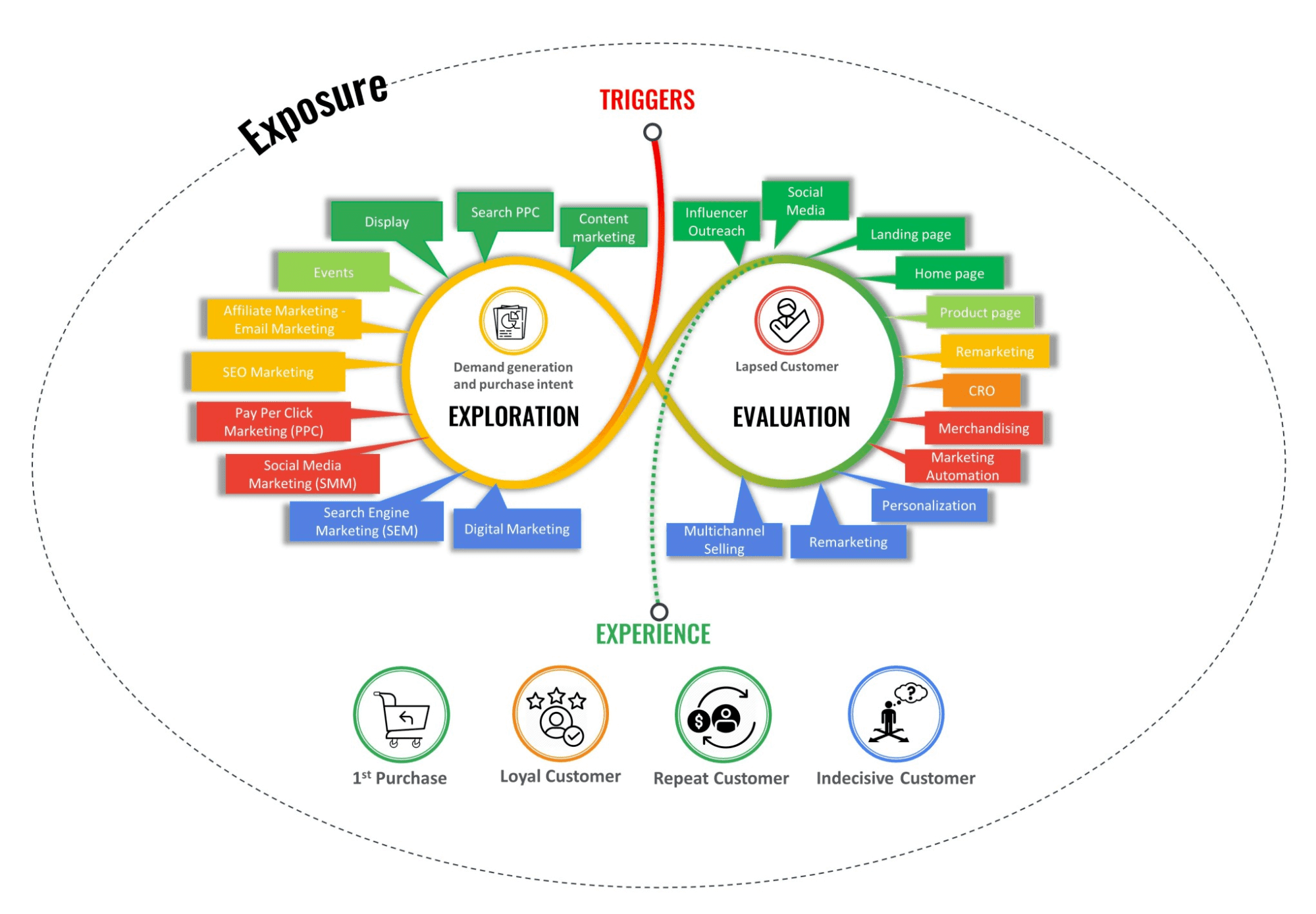I recently had the chance to attend the Search Marketing Expo (SMX) conference in Paris. I’m excited to share some insights with you. While there were many interesting topics discussed at the conference, I want to highlight two that stood out to me. The first one is an inspirational topic that discusses the changing paradigm of shopping behaviour. The second topic is more technical and focuses on leveraging your knowledge in GA4. Specifically, we’ll be discussing the messy middle and how to use it to your advantage, as well as the power of conversion funnels in GA4. So, let’s dive in and explore these two fascinating topics!
What is the messy middle and how to use it?
What is the messy middle?
It’s a study that aimed to understand how consumers make decisions in an online environment of abundant choice and limitless information. The researchers worked with behavioural science experts to understand how cognitive biases shape shopping behaviour in the messy middle, where customers are won and lost. Through the study, they identified two different mental modes, exploration, and evaluation, that consumers go through as they research and make purchase decisions.

The user will have a trigger that’s pushing them to buy something. They will then go under 2 phases :
- First, the exploration phases, where they will be looking at and collecting information about different brands and products to buy.
- Then, they will evaluate one brand or product and see if this is matching with his/her needs. If so, they will purchase it. If not, they will enter a new phase of exploration.
If you want to know more about the study, you can read some explanations here. And you can also download the full study, which we encourage you to do.
This challenges the conventional buyer paradigm, which is typically represented as a conversion funnel that progresses from awareness to consideration to conversion. The result is a paradigm that appears more like the following:

So then, what influences shopping behaviour? Google identifies 6 cognitive biases:

What does that mean for each of them?
- Category heuristics: using the general tendency that having shortcuts, key product specifications is helping the purchase decision as fewer pieces of information need to be treated. Ex: how many megapixels the camera of a smartphone has.
- Power of now: using the general tendency to want things now rather than later. Ex: 24-hour delivery.
- Social proof: using the general tendency to copy the behaviour and actions of other people in situations of ambiguity or uncertainty. Ex: star rating of products or services.
- Scarcity bias: using the economic principle that rare or limited resources are more desirable. This could be time limitation or quantity limitation or access limitation. Ex: only 2 left.
- Authority bias: using the general tendency to follow the lead of people we believe to be credible and knowledgeable experts. Ex: this toothpaste is approved by 95% of dentists.
- Power of free: using the general observation that the demand for a product or service is significantly greater at a price of exactly zero compared to a price even slightly greater than zero. Ex: free trial.
What is the impact?
Basically, what marketers used to see as big different silos, branding and performance, traditionally divided are actually overlapping in the messy middle. How to stand out in the messy middle?
To effectively navigate this terrain, it’s essential to ensure that your digital strategy is optimized for key moments of exploration and evaluation. By leveraging shopping behavioural biases and providing shoppers with the information and reassurance they need, you can help guide them towards a purchase.
To streamline this process, it’s crucial to optimize site speed, user experience, and onsite messaging to shorten the distance between trigger and purchase. Additionally, leveraging the creative aspect of your messaging and continuously testing it will help ensure that you stand out in the crowded digital landscape.
If you need assistance navigating this complex digital terrain, don’t hesitate to contact us. Our team of experts is here to help you every step of the way.
The power of conversion funnels in GA4
In this topic, Romain Trublard and Bruno Guyot shared how to create effective conversion funnels within the explore section of GA4. The goal is to track the behaviour of website users along the customer journey and identify pain points. It’s a relatively easy process, and they use the example of an online form to explain it further. Let’s deep-dive into it :
1) To begin, ensure that you have proper tracking in place for each step of the form. You can achieve this by using an existing data layer or creating a custom HTML script to trigger an event for each step. If you need help creating the script, ChatGPT can assist you.
2) Next, create a GA4 tag for each step of the form, along with a variable that captures the relevant event information.
3) Once you’ve set up your triggers and tags, create a custom dimension in GA4 using an event-based dimension and add the variable as a parameter.
4) With your tracking in place, it’s time to build your funnel in the GA4 “funnel exploration” report. Add all relevant segments, and then create the funnel event by event, adding each as a step before or after the other.
5) Once completed, explore the funnel to identify any drop-offs and begin testing to reduce them.
It’s important to keep in mind that the funnel in GA4 does not allow users to step back to a further stage. For example, if a user skips an optional field, it will be seen as a drop-off. If the user keeps on filling the form in the next field, it won’t appear in the funnel exploration anymore. Therefore, it’s crucial to build your form and funnel carefully and also consider the pre-filling features that could affect the user’s journey. If you have fields that could be pre-filled, make sure that they all follow each other. If you need further assistance with this, don’t hesitate to contact us.
Get our ramblings right in your inbox
We deepdive into hot topics across digital marketing and love to share.



